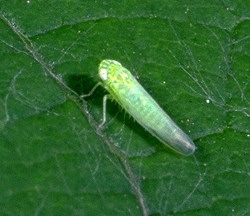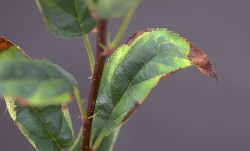Potato Leafhoppers
ENTFACT-115: Potato Leafhoppers | Download PDF
by Lee Townsend, Extension Entomologist
University of Kentucky College of Agriculture
The adult potato leafhopper is winged, pale green, wedge-shaped insect about 1/8-inch long. The pale green to yellow nymphs, are wingless, smaller than the adults, and very quick. Consequently they can remain unnoticed until the plants show "hopperburn". Both stages feed on the undersides of leaves. They run when disturbed, moving quickly to the opposite side of the leaf or stem like a squirrel running around a tree trunk.
PLH Adult
Potato leafhoppers do not survive the winter in Kentucky. Large numbers migrate northward from the Gulf states each spring. Females live about a month.
Each can deposit 2 or 3 tiny white eggs a day in the stems and large leaf veins of the plant. The tiny nymphs emerge from these eggs in a 7 to 10 days, they reach the adult stage about two weeks later. The entire life cycle takes about a month, there are three or four generations in Kentucky each year.
PLH Nymph
Hopperburn, the yellow, wedge-shaped area at the tips of alfalfa leaves, is the plant's distinctive response to leafhopper feeding. This damage is due to a toxic effect of the insect's saliva.
Diseases and nutritional deficiencies also cause yellowing of alfalfa. These symptoms usually start at the edge of the leaf but are not confined to the tips. Intense leafhopper feeding may reduce plant height, protein and vitamin A content of the hay.
PLH Damage: "Hopperburn"
Leafhopper feeding can cause yellowing of soybean plants. However, this symptom is more often due to root or stem rots, nutrient deficiencies, waterlogged soils, soybean cyst nematodes. Stress to the plant is usually worse under very dry conditions. An average of 6 or more leafhoppers per plant at flowering, or 13 or more at mid-pod development, are thought to be needed to cause significant problems.
Control
Leafhoppers are seldom a problem on the first cutting of established alfalfa, but can damage later cuttings. In fall-seeded alfalfa, they can become numerous enough before the first harvest to cause significant damage. A 35-day harvest schedule generally keeps leafhoppers from building to large numbers. Cutting drives the winged adults out of the field. The wingless nymphs are unable to leave and most starve or die from some other cause before regrowth gets started.
Alfalfa fields must be checked carefully with a sweep net to detect damaging numbers of leafhoppers before symptoms appear.
SAMPLING PROCEDURES
When to sample:
Established alfalfa fields should first be sampled one week after the first cutting. New seedings of alfalfa should be sampled beginning in mid-May. Spring seedings of alfalfa are not cut until late June or early July and they often build up damaging leafhopper populations. Alfalfa fields can be sampled anytime during the day as long as the foliage is not wet. Sweeping alfalfa when it is wet from dew or rain is difficult and the samples are almost impossible to count.
Equipment needed:
Yardstick or other measuring device. 15" diameter sweep net (available at many county extension offices). Pencil and paper.
How to sample:
- Sweep sample at five locations in the field. Take 20 sweeps at each location- a total of 100 sweeps per field.
- Count all potato leafhoppers (adults and nymphs) collected at each location and record these numbers.
- Randomly collect 10 complete stems as you walk back out of the field. Calculate the average stem height, examine each of the 10 stems for buds or flowers and record this information.
- Compute the number of leafhoppers per sweep and use the "Potato Leafhopper Economic Threshold Table" below to determine if control measures are needed. ENT-17, Insecticide Recommendations for Alfalfa, Clover, and Pastures contains specific control recommendations.
Determining the need for leafhopper control:
Samples made just prior to the cutting of alfalfa will be useful in determining the potential for damage in the field. If high numbers of leafhoppers (two or more/sweep) are present at that time, spraying after cutting may be necessary to prevent economic damage. Resample the field within 7 days after cutting to determine whether control measures are needed. After the first cutting, and for every additional cutting, use the Economic Threshold Table below to determine when potato leafhoppers should be controlled. If your leafhopper counts exceed the critical values on the table, control measures should be implemented.
Early harvests often can be used to control potato leafhoppers. If the alfalfa is at 30% bud or more you should plan on cutting within 7-10 days. If this is the case, you should not spray. Soon after cutting you should resample the field to determine the need for control. An insecticide application may be needed, especially early in the regrowth period.

PLH Economic Threshold Table
Revised: 12/02
CAUTION! Pesticide recommendations in this publication are registered for use in Kentucky, USA ONLY! The use of some products may not be legal in your state or country. Please check with your local county agent or regulatory official before using any pesticide mentioned in this publication.
Of course, ALWAYS READ AND FOLLOW LABEL DIRECTIONS FOR SAFE USE OF ANY PESTICIDE!
Photos courtesy Lee Townsend & Ric Bessin, University of Kentucky Entomology



